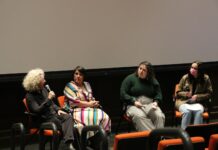Author: Natania Reed, Senior Writer
In an unprecedented look at female artists of the surrealist movement, the Los Angeles County Museum of Art (LACMA) opened its doors on Jan. 29 to “In Wonderland: The Surrealist Adventures of Women Artists in Mexico and the United States.” As the placard introducing the exhibition stated, this collection is the first exhibition dedicated to female figures in this male-dominated cultural movement of surrealism. The expansive exhibit features almost 50 different artists, from iconic figures like Frida Kahlo, Dorothea Tanning and Lee Miller, to lesser-known practitioners. In a multitude of different artistic mediums, including painting, photography and film, the exhibit explores the different ways in which female surrealist artists pushed the boundaries of art. Issues of identity, sexuality, domesticity and heritage have mostly been ignored by male surrealists but are explored throughout “In Wonderland.”
Much of the exhibition features self-portraiture, a popular topic in surrealist women’s art. In one of her most famous images, Frida Kahlo’s 1939 “Las dos Fridas (The Two Fridas),” the artist paints two images of herself, side by side, holding hands and connected by one artery. The oil on canvas painting explores the duality and multifaceted nature of identity. Her artery is attached to a small portrait of Diego Rivera, Kahlo’s husband for a period of years, further complicating the artist’s portrayal of identity and self. Kahlo explores the self-portrait further in another work featured at the exhibit, called “Autorretrato con collar de espinas y colibri (Self Portrait with Thorn Necklace and Hummingbird).” Created in 1940, this oil painting is a close-up of the artist’s face, with a complex necklace made out of thorns and jungle imagery in the background.
Kahlo was not alone in her utilization of the self-portrait. American Painter Helen Lundeberg’s “Double Portrait of the Artist in Time” (1935) displays the artist as a baby, sitting at a table with a clock, an obvious reference to time. The child’s shadow is that of the adult Lundeberg. The examination of identity and age manifests itself as the shadow blends into another image of the artist as an older woman.
Additionally, “In Wonderland” contains many pieces that pertain to sexuality and the body. The female figure was a prominent theme in surrealist artwork, though in the male-dominated culture it was traditionally objectified and made into the subject of the male gaze. Female artists sought to overturn this construction of the female body through their artwork, transforming it from an object of male desire to a site of resistance.
Mina Loy’s 1930 “Surreal Scene,” small in size but powerful in meaning, deconstructs the female body by drawing a woman surrounded by her different body parts, a scene of floating legs and ribs. The piece attempts to subvert and mock the glorification of women as sexual objects in many male artists’ work. Louise Bourgeois also critiques the male dominated society in her piece “Persistent Antagonism (Personage)” (1947-49), a wooden sculpture with metal pieces. The sculpture, which deliberately resembles both a skyscraper and a phallic symbol, creates a parallel between architecture and the human body.
Similar to the deconstruction and reinterpretation of the female body, female surrealist artists often attempted to deconstruct the patriarchal structure of marriage and domesticity. Seeking liberation from traditional roles of wife, mother and homemaker, surrealist women often challenged social norms through their artwork. Chicago-based painter Gertrude Abercrombie’s “The Courtship” (1949) criticizes traditional structures of marriage and relationships by comparing a courtship between a man and a woman to a hold-up. In front of a barren landscape, Abercrombie portrays a masked man with his hand in the shape of a gun next to a woman, who holds her hands up in defeat. Another critique of patriarchal culture is Bourgeois’ “Femme Maison (Woman House)” (1946-47), an ink on linen drawing. The drawing features the outline of a woman whose upper half is comprised of a house. The image makes clear reference to domesticity and women’s assumed role in the household.
“In Wonderland” challenges the tradition of a male-dominated art culture. A majority of the exhibit focuses on art between the years of 1931 to 1968, a time when patriarchal structures restricted women and society demanded domesticity. The exhibition consequently reveals not only the personal goals of female artists but also a larger movement toward social equality. The exhibit will run at LACMA until May 6 and requires a $20 reservation.
This article has been archived, for more requests please contact us via the support system.
![]()






































